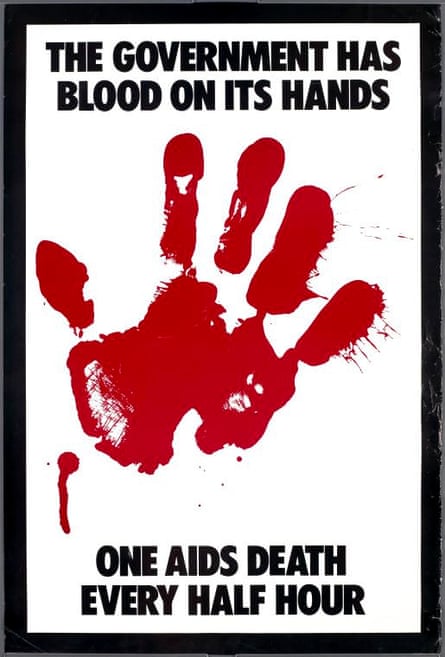‘The start of the national Aids movement’: Act Up’s defining moment in queer protest history
‘The start of the national Aids movement’: Act Up’s defining moment in queer protest history The Guardian


Seize Control of the FDA: A Landmark Protest for AIDS Activism
On a chilly October morning in 1988, about 1,500 protesters descended upon a nondescript glass office building in suburban Rockville, Maryland. They were AIDS patients, friends, and queer activists from all over the country protesting what they saw as the failures of the US Food and Drug Administration (FDA) to approve medications to fight AIDS. The disease had already killed at least 45,000 Americans in less than a decade.

The Birth of a Movement
As amused and quizzical government employees watched from the windows, protesters marched in circles in front of kitted-up riot police. The protesters lifted posters in the air, many with the now-iconic image of a bloody handprint and the words: “The government has blood on its hands; one AIDS death every half hour.” They chanted: “Fifty-two will die today/ Seize control of the FDA!”
From within the crowd emerged 27-year-old activist and AIDS patient Peter Staley, wearing a knapsack containing a rolled-up banner proclaiming Act Up’s slogan, “Silence=Death”, and a roll of tape, headed straight for FDA’s front door.
“I didn’t think I was going to survive five years beyond that moment,” Staley told the Guardian this week. So he did what he could to draw attention to their plight.
With a boost from friends, Staley catapulted onto the concrete awning over the entryway, a
SDGs, Targets, and Indicators
| SDGs | Targets | Indicators |
|---|---|---|
| SDG 3: Good Health and Well-being | Target 3.3: By 2030, end the epidemics of AIDS, tuberculosis, malaria, and neglected tropical diseases and combat hepatitis, water-borne diseases, and other communicable diseases | Indicator not mentioned in the article |
| SDG 5: Gender Equality | Target 5.6: Ensure universal access to sexual and reproductive health and reproductive rights as agreed in accordance with the Programme of Action of the International Conference on Population and Development and the Beijing Platform for Action and the outcome documents of their review conferences | Indicator not mentioned in the article |
| SDG 10: Reduced Inequalities | Target 10.3: Ensure equal opportunity and reduce inequalities of outcome, including by eliminating discriminatory laws, policies, and practices and promoting appropriate legislation, policies, and action in this regard | Indicator not mentioned in the article |
| SDG 16: Peace, Justice, and Strong Institutions | Target 16.7: Ensure responsive, inclusive, participatory, and representative decision-making at all levels | Indicator not mentioned in the article |
1. Which SDGs are addressed or connected to the issues highlighted in the article?
- SDG 3: Good Health and Well-being
- SDG 5: Gender Equality
- SDG 10: Reduced Inequalities
- SDG 16: Peace, Justice, and Strong Institutions
2. What specific targets under those SDGs can be identified based on the article’s content?
- Target 3.3: By 2030, end the epidemics of AIDS, tuberculosis, malaria, and neglected tropical diseases and combat hepatitis, water-borne diseases, and other communicable diseases (under SDG 3)
- Target 5.6: Ensure universal access to sexual and reproductive health and reproductive rights as agreed in accordance with the Programme of Action of the International Conference on Population and Development and the Beijing Platform for Action and the outcome documents of their review conferences (under SDG 5)
- Target 10.3: Ensure equal opportunity and reduce inequalities of outcome, including by eliminating discriminatory laws, policies, and practices and promoting appropriate legislation, policies, and action in this regard (under SDG 10)
- Target 16.7: Ensure responsive, inclusive, participatory, and representative decision-making at all levels (under SDG 16)
3. Are there any indicators mentioned or implied in the article that can be used to measure progress towards the identified targets?
No indicators are mentioned or implied in the article that can be used to measure progress towards the identified targets.
4. Table: SDGs, Targets, and Indicators
| SDGs | Targets | Indicators |
|---|---|---|
| SDG 3: Good Health and Well-being | Target 3.3: By 2030, end the epidemics of AIDS, tuberculosis, malaria, and neglected tropical diseases and combat hepatitis, water-borne diseases, and other communicable diseases | Indicator not mentioned in the article |
| SDG 5: Gender Equality | Target 5.6: Ensure universal access to sexual and reproductive health and reproductive rights as agreed in accordance with the Programme of Action of the International Conference on Population and Development and the Beijing Platform for Action and the outcome documents of their review conferences | Indicator not mentioned in the article |
| SDG 10: Reduced Inequalities | Target 10.3: Ensure equal opportunity and reduce inequalities of outcome, including by eliminating discriminatory laws, policies, and practices and promoting appropriate legislation, policies, and action in this regard | Indicator not mentioned in the article |
| SDG 16: Peace, Justice, and Strong Institutions | Target 16.7: Ensure responsive, inclusive, participatory, and representative decision-making at all levels | Indicator not mentioned in the article |
Behold! This splendid article springs forth from the wellspring of knowledge, shaped by a wondrous proprietary AI technology that delved into a vast ocean of data, illuminating the path towards the Sustainable Development Goals. Remember that all rights are reserved by SDG Investors LLC, empowering us to champion progress together.
Source: theguardian.com

Join us, as fellow seekers of change, on a transformative journey at https://sdgtalks.ai/welcome, where you can become a member and actively contribute to shaping a brighter future.







